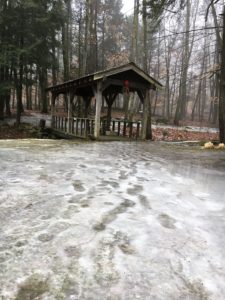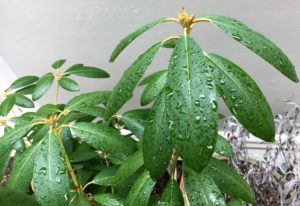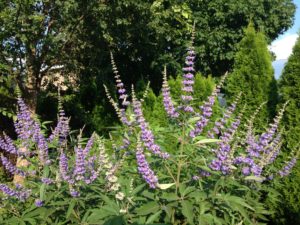Hello fellow readers,
As I sit to write you, I remain wobbly from a bout of flu. Just as I feel I’m improving, there’s a setback. The fever returns or coughing fits, making it tough to breathe. It’s been humbling, yet minor compared to others dealing with a serious illness or devastating loss. Prayers.
Thankfully the tundra from the last snow that created an ice rink of chaos has melted. I still have a patch left with frozen footprints in standing water amid a muddy border. From a frigid December to an unusually warm spell, no wonder germs are running amuck. Today’s rain adds to the dreariness of the landscape, but even in the dreariness, there’s beauty.
I noticed while strolling to Ellie’s morning spot that droplets of rain were clinging to the wispy, dry flowerheads on the Little Princess Spirea (Spiraea japonica). The rhododendrons have uncurled their leaves after being tightly curled to help hold moisture during the wintery winds. They seem excited about upcoming growth, with dewy drops resting on their happy-to-be-open leaves. Indeed, there’s beauty in anticipating spring when dreariness turns to green. Even those of you who live in forever green locales have new growth to look forward to. Around here, signs in front of nurseries announce, “Spring is on its way- opening March 16th.” Yippee! Hold your britches, though. There’s more winter to come.
Speaking of Spirea. At the NJ Plants Show in Edison, NJ, on the last of January, Bruce Crawford of Rutgers University gave a talk about plants considered invasive on “official-looking” Do Not Plant lists. These lists are not “official” unless there’s a law not to plant them. In fact, many of the plants if planted in the right spot, are not invasive. For example, “You can cut down spirea to the ground in winter, and it will flower again next year,” Bruce suggested as a way to inhibit volunteers. Unlike spirea, whose seeds can germinate in mulch, butterfly bush seeds (Buddleja davidii) don’t typically germinate there. Rather, they like warm spots like gravel or nooks and crannies between rocks. The same is true with Vitex (Vitex agnus-castus). So, plant them away from hot spots, though I love the volunteers in the boulder walls between our barns.
“Use plants in situations where they are less likely to seed,” Bruce advised. Such as Fountain Grass, Pennisetum alopecuroides, whose seeds blow ten to fifteen feet. For finicky lawn folks (not me) plant them fifteen feet from your lawn. “Or use ‘Karley Rose’ Fountain Grass, Pennisetum orientale, which doesn’t seed.”
Of course, adhere to Do Not Plant lists if they are law. But prolific seeders, when planted in the right spot, won’t become invasive, unlike this darn influenza virus running amuck. Stay tuned next week for more advice from Bruce Crawford’s talk. But for now, I must sign off and tend to my stuffy nose. Garden Dilemmas? Askmarystone@gmail.com and your favorite Podcast App.
Column Updated 1/13/24





